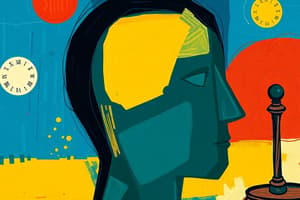Podcast
Questions and Answers
What is a significant barrier to help seeking for older adults with depression and anxiety?
What is a significant barrier to help seeking for older adults with depression and anxiety?
- Preference for counseling over medication
- High rates of depression in older populations
- Availability of support groups
- Stigma surrounding mental health treatment (correct)
Which factor is NOT considered in the Strength and Vulnerability Integration Model (SAVI)?
Which factor is NOT considered in the Strength and Vulnerability Integration Model (SAVI)?
- Wisdom
- Time horizons
- Life experiences
- Socioeconomic status (correct)
What is the most commonly used treatment for anxiety and depression in older adults?
What is the most commonly used treatment for anxiety and depression in older adults?
- SSRIs (correct)
- Psychodynamic therapy
- Group therapy
- Mindfulness-based therapy
What percentage of older adults with depression or anxiety actually receive treatment?
What percentage of older adults with depression or anxiety actually receive treatment?
What is one outcome of the cohort effect observed in older adults regarding mental health?
What is one outcome of the cohort effect observed in older adults regarding mental health?
What is a common biological change experienced by women during midlife?
What is a common biological change experienced by women during midlife?
Which of the following is TRUE about the cognitive changes in midlife?
Which of the following is TRUE about the cognitive changes in midlife?
What does the concept of 'The Sandwich Generation' primarily refer to?
What does the concept of 'The Sandwich Generation' primarily refer to?
Which psychosocial conflict characterizes the midlife stage according to Erikson's theory?
Which psychosocial conflict characterizes the midlife stage according to Erikson's theory?
Which of the following is a common milestone experienced in midlife?
Which of the following is a common milestone experienced in midlife?
What is a symptom commonly associated with menopause?
What is a symptom commonly associated with menopause?
Which of the following reflects stagnation in midlife?
Which of the following reflects stagnation in midlife?
What is a potential impact of generativity during midlife?
What is a potential impact of generativity during midlife?
What is the term used to describe the social task of ensuring generativity versus stagnation in mid-adulthood?
What is the term used to describe the social task of ensuring generativity versus stagnation in mid-adulthood?
Which of the following is NOT considered a typical activity to promote generativity?
Which of the following is NOT considered a typical activity to promote generativity?
What age group is classified as 'young old' in older adulthood?
What age group is classified as 'young old' in older adulthood?
Which of the following is a modifiable risk factor for dementia?
Which of the following is a modifiable risk factor for dementia?
In the context of socioemotional selectivity theory, how do people prioritize their goals when they perceive their time as limited?
In the context of socioemotional selectivity theory, how do people prioritize their goals when they perceive their time as limited?
Which of the following is a misconception about older adults as a result of ageism?
Which of the following is a misconception about older adults as a result of ageism?
What does successful aging typically entail?
What does successful aging typically entail?
Which type of ageism is characterized by negative perceptions of older adults held by individuals in society?
Which type of ageism is characterized by negative perceptions of older adults held by individuals in society?
What is a common physical change that occurs in older adulthood?
What is a common physical change that occurs in older adulthood?
Which of the following best describes the impact of understanding and insight on selective optimization with compensation in older adults?
Which of the following best describes the impact of understanding and insight on selective optimization with compensation in older adults?
Meta-analysis found that when treating older adults with anxiety and depression, which of the following statements is correct?
Meta-analysis found that when treating older adults with anxiety and depression, which of the following statements is correct?
What is the primary reason older adults have the lowest rates of help-seeking for their mental health?
What is the primary reason older adults have the lowest rates of help-seeking for their mental health?
How prevalent is anxiety and depression in older age?
How prevalent is anxiety and depression in older age?
The Strength and Vulnerability Integration Model outlines:
The Strength and Vulnerability Integration Model outlines:
The Socioemotional Selectivity Theory focuses on which of the following?
The Socioemotional Selectivity Theory focuses on which of the following?
Are older people sadder than younger people?
Are older people sadder than younger people?
What is the Erikson psychosocial issue for older adults?
What is the Erikson psychosocial issue for older adults?
At what age do women typically experience perimenopause?
At what age do women typically experience perimenopause?
Flashcards
Midlife
Midlife
The period of life between the ages of 40 and 65, characterized by significant changes in physical, social, and psychological aspects.
Perimenopause
Perimenopause
A transition phase leading to menopause, marked by hormonal fluctuations and irregular periods.
Menopause
Menopause
A biological event in women, marked by the cessation of menstruation, usually occurring between the mid-40s and mid-50s.
Male hormonal changes
Male hormonal changes
Signup and view all the flashcards
Fluid intelligence
Fluid intelligence
Signup and view all the flashcards
Crystallized intelligence
Crystallized intelligence
Signup and view all the flashcards
Sandwich generation
Sandwich generation
Signup and view all the flashcards
Generativity
Generativity
Signup and view all the flashcards
Stagnation
Stagnation
Signup and view all the flashcards
Midlife correction
Midlife correction
Signup and view all the flashcards
Midlife crisis
Midlife crisis
Signup and view all the flashcards
Older adulthood
Older adulthood
Signup and view all the flashcards
Oldest-old
Oldest-old
Signup and view all the flashcards
Ageism
Ageism
Signup and view all the flashcards
Older adults are an economic burden
Older adults are an economic burden
Signup and view all the flashcards
All older adults need nursing homes
All older adults need nursing homes
Signup and view all the flashcards
Depression and loneliness are normal
Depression and loneliness are normal
Signup and view all the flashcards
Dementia is inevitable
Dementia is inevitable
Signup and view all the flashcards
Normal Cognitive Aging
Normal Cognitive Aging
Signup and view all the flashcards
Older adults cannot learn
Older adults cannot learn
Signup and view all the flashcards
Integrity vs. Despair
Integrity vs. Despair
Signup and view all the flashcards
Socioemotional Selectivity Theory
Socioemotional Selectivity Theory
Signup and view all the flashcards
Selective Optimization with Compensation (SOC)
Selective Optimization with Compensation (SOC)
Signup and view all the flashcards
Strength and Vulnerability Integration Model (SAVI)
Strength and Vulnerability Integration Model (SAVI)
Signup and view all the flashcards
Depression and anxiety
Depression and anxiety
Signup and view all the flashcards
Suicide in older adults
Suicide in older adults
Signup and view all the flashcards
Low help-seeking rates
Low help-seeking rates
Signup and view all the flashcards
Life review
Life review
Signup and view all the flashcards
Barriers to mental health treatment
Barriers to mental health treatment
Signup and view all the flashcards
Dementia
Dementia
Signup and view all the flashcards
Modifiable risk factors for dementia
Modifiable risk factors for dementia
Signup and view all the flashcards
Study Notes
Midlife (40-65 years)
- Common milestones for this stage of life include: parenting, children leaving home, becoming a grandparent, marriage or marital struggles, divorce, new relationships, career prime time or transitions, retirement planning or early retirement, menopause, and physical changes.
- Biological changes in midlife include wrinkles, gray hair, hair loss, weight gain, skin changes (smoking and sun exposure can have an impact), bone mass loss, osteoarthritis, rheumatoid arthritis, vision changes, metabolism changes, and an increased risk of health problems like cardiovascular disease, cancer, and high blood pressure.
- Hormonal and reproductive changes affect both men and women.
- Women experience perimenopause and menopause. Perimenopause is a transition phase leading to menopause. Menopause is defined as more than 12 months without a period. Menopause occurs typically between the mid-40s and mid-50s and lasts about 7 years. Women experience rapid decreases in estrogen and progesterone during this phase.
- In men, there's a gradual decrease in testosterone.
- Cognitive changes during this period include a peak in fluid intelligence (reasoning and problem solving) and crystallized intelligence (accumulated knowledge and experiences). Numerical abilities and perceptual speed tend to decrease.
- The "sandwich generation" refers to people in midlife who need to support both their aging parents and their growing children. This can lead to financial pressures, a high caregiving burden, and impact mental health.
- Other social pressure changes include the later receipt of inheritance, which can affect home buying and mortgage payments.
- Erikson's stage of psychosocial development for this period is Generativity vs. Stagnation. Generativity focuses on contributing to the world and leaving a positive mark. Stagnation is characterized by feeling like one has not done anything worthwhile, boredom, and disconnection.
- Generativity is associated with better health, more positive relationships, greater productivity, fulfillment, and connectedness.
- Stagnation is associated with reduced cognitive function (possibly due to depression), poorer health, low quality relationships, and decreased life satisfaction.
- Mid-life crisis and empty nest syndrome are not universal experiences and depend on factors like personality, individual psychology, and societal "social clocks."
- Mid-life correction refers to adjusting one's life because of feeling off-track, which may happen in various domains like work, social life, family, and hobbies.
- Activities that promote generativity include social participation and connections, taking on more responsibilities, mentoring, and volunteering.
Older Adulthood (Over 65 Years)
- Life expectancy is increasing for both men and women, with women living longer than men.
- Older adulthood is categorized into young-old (65-74 years), middle-old (75-84), and oldest-old (85+).
- Transitions in older adulthood include retirement, health conditions, adjusting to physical and sensory changes, maintaining cognitive function, adapting to social and community role changes, and bereavement.
- Ageism is a prevalent issue affecting older people. It can be self-directed, interpersonal, or institutional.
- Some commonly encountered misconceptions about older adults include: they are an economic burden, all older adults are unwell and in nursing homes, depression, and loneliness are normal, dementia is inevitable, older adults cannot learn new things, older adults are asexual, and they should be passive, uncomplaining, happy, and forgetful.
- Ageism can be addressed through policy and law changes, education, and intergenerational activities.
- Successful aging moves away from a deficit focus and emphasizes maintaining high cognitive and physical capabilities, living free from disability and disease, and having meaningful interactions with others.
- Physical changes in older adulthood include brain atrophy, decreased neural processing speed, respiratory and circulatory changes, bone loss (osteoporosis), muscle loss, skin changes, hair loss, and decreased sensory perception.
- Cognitive changes include a normal age-related decline in processing speed, short-term and working memory. Older adults can still learn new things with repetition.
- Dementia affects approximately 1 in 10 people over 65.
- Risk factors for dementia can be categorized as non-preventable (age, genetics, family history) and modifiable (target 12 risk factors to prevent or delay dementia by 40%).
- Wellbeing in older adults is typically higher than in younger adults.
- Erikson's psychosocial stage for this period is Integrity vs. Despair. This stage centers around reflecting on one's life and answering the question, "Did I lead a meaningful life?" Retirement, bereavement, and illness can trigger this reflection. A life review helps create a coherent life narrative.
- Death anxiety is generally lower in older adults.
- Older adults experience better regulation of emotions and lower rates of mental illness (excluding dementia).
Theories of Aging
- Selective Optimization with Compensation (SOC): Baltes (1980) proposed that older people need to select their best abilities and use them to compensate for declines or losses. This includes:
- Selection: Choosing valued activities, best abilities, and most intact functions (elective or loss-based).
- Optimization/Compensation: Overcoming limitations through strategic use of resources.
- Socioemotional Selectivity Theory (SST): Suggests that time perception is a key factor in social goal selection.
- When time is perceived as long, knowledge goals are prioritized.
- When time is perceived as short, emotional goals are prioritized.
- Older adults have shrinking time horizons due to their proximity to death.
- This prioritizes emotion-related goals, meaning and emotional wellbeing, and present-focused goals over future-focused ones.
- Strength and Vulnerability Integration Model (SAVI): Considers both time horizons and life experiences, including wisdom. This model suggests that:
- Older adults remember positive things better.
- They are better at regulating emotions through attentional avoidance and finding silver linings.
- However, they have reduced physiological flexibility.
Mental Health in Older Adults
- Depression and anxiety are the most common mental disorders in older adults (excluding neurocognitive disorders).
- Around 1 in 20 older adults experience either depression or anxiety.
- There's a significant overlap between these two conditions, with up to 50% of cases being comorbid (occurring together).
- Older adults have the highest suicide rate, reaching a peak in males over 85.
- Rates of help-seeking are low, with only 26% of older adults receiving treatment.
- Barriers to treatment include cost, stigma, preference for self-help, concerns about medication, transportation issues, and failure to identify the need for help.
- Under-recognition by healthcare professionals, prioritization of physical problems over mental health, and resource constraints contribute to these barriers.
- Treatments for anxiety and depression include SSRIs and psychotherapy, with CBT and problem-solving therapy showing greater benefits for depression, and CBT showing moderate benefits for anxiety.
Studying That Suits You
Use AI to generate personalized quizzes and flashcards to suit your learning preferences.





